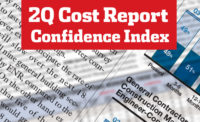 The market has been robust for several years and continues to be so today. However, many firms worry that economic and political uncertainties are starting to cloud the future of the buildings market. While firms fret about buildings and industrial projects, those working in the public infrastructure markets are growing more enthusiastic about their prospects.
The market has been robust for several years and continues to be so today. However, many firms worry that economic and political uncertainties are starting to cloud the future of the buildings market. While firms fret about buildings and industrial projects, those working in the public infrastructure markets are growing more enthusiastic about their prospects.
The ENR Construction Industry Confidence Index for the second quarter shows that, of the 209 executives of large construction and design firms responding to the survey, most believe market growth will begin to level off in 2017. The CICI index was 62 on a scale of 100, up one point from the first quarter.
The CICI measures executive sentiment about the current market and reflects the respondents’ views on where it will be in the next three to six months and over a 12- to 18-month period. The index is based on responses to surveys sent out to more than 6,000 U.S. firms on ENR’s lists of leading general contractors, subcontractors and design firms. The latest survey was conducted from June 1 through June 27.
The general building market is showing signs of losing momentum. When applying the CICI formula to individual market sectors, six of the nine general building sectors declined in the second quarter, compared to last quarter’s ratings. Execs from firms working in the retail sector believe that sector currently is flat and expect it to decline going forward. The only buildings sectors that showed strengthening confidence in the second quarter were health care, distribution and warehouses, and entertainment, cultural and theme parks.
On the other hand, firms in the public infrastructure markets showed growing confidence in their sectors. The growing public concern over the state of infrastructure as well as the passage of the federal Fixing America’s Surface Transportation (FAST) Act, which ensures long-term federal funding assistance for transportation programs, have boosted prospects for the transportation, water and sewer sectors. The water/sewer-waste market is now the highest rated of the 15 sectors in the CICI survey.
|
Click Here to Read the Cost Report (subscription required) |
CFMA Members Are Looking Ahead
The soon-to-be-released results of the latest Confindex survey from the Construction Financial Management Association, Princeton, N.J., also is showing an increased sense of concern about 2017. CFMA polls 200 CFOs each quarter from general and civil contractors and subcontractors.
While a Confindex rating of 100 indicates a stable market, higher ratings show growth is expected. “Our Confindex fell from 123 in the first quarter, down to 121 [on a scale of 200] in this quarter,” says Stuart Binstock, CEO of CFMA.
Binstock says the Confindex’s “current business conditions” component actually rose two points to 129 from 127. “The market is about as strong as I have seen it in the five years I have been with CFMA,” he says. However, Binstock notes that the “year ahead” component of the index tumbled 5%, to 111, in this quarter from 117 in the first quarter and is down 13% from a year ago, indicating CMFA members are increasingly wary about how long the strong market will last.
“There are fears among CFOs that we are, perhaps, in the seventh inning of this growth cycle,” says Anirban Basu, CEO of economic consultant Sage Policy Group Inc., Baltimore, and CFMA economic adviser. He says now is the time to prepare for a softening market.
The Money Is There
CICI respondents fear that some sectors in the general building market may be getting overbuilt. For example, for nearly two years, survey participants have been predicting a downturn in the booming multi-unit residential sector. However, the demand for apartments in urban areas forestalled the predicted downturn.
Part of the reason for the activity in the buildings market is that money continues to be available for developers to finance projects. Each quarter, ENR asks construction execs about their clients’ access to capital for project financing. This quarter, 61% of survey respondents said client access to project funding has been unchanged over the past six months, while 21% said financing was easier to secure and 18% said it was tougher.
However, Basu says bank regulators are becoming increasingly concerned about the level of real estate loans in bank portfolios, so the fear of regulator intervention may cause a pullback in bank lending to real estate developers.
On the other hand, economic and political turmoil outside the U.S. and very low interest rates offered on government-backed securities have prompted an increase in the foreign money coming into the U.S. “Foreign investors are coming to the U.S. seeking not just a safe place to park their cash but [also] for real returns on their investments,” says Basu.
Much of this money is going into real estate developments, he says, which could cause long-term problems in the buildings market. The volume of foreign investment may be “the tail wagging the dog, resulting in investments in building stock we may not need,” Basu says.
“There may be projects under development now that may not find tenants when they are complete,” Basu says. If a downturn were to occur, the significant overstock of buildings could interfere with any recovery in that market until vacancy rates drop, he says.





Post a comment to this article
Report Abusive Comment